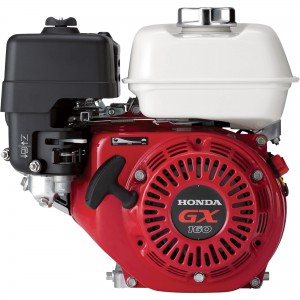 The horizontal shaft Honda GS can be found in a wide range of residential lawn and garden equipment as well as commercial equipment that puts a premium on low weight. No matter what your GS engine is powering, there are a few things you should know about it to get the most out of your motor.
The horizontal shaft Honda GS can be found in a wide range of residential lawn and garden equipment as well as commercial equipment that puts a premium on low weight. No matter what your GS engine is powering, there are a few things you should know about it to get the most out of your motor.Controls
Honda makes three versions of these engines, each with their own unique control setup. The controls can be found just to the right of the fuel tank, although some equipment may use remote levers for these functions. All model have a metal loop handle to control the choke: pulling it out closes the choke. Next to the choke, you’ll see one of three controls:
A gray manual throttle lever – Moving the lever up opens the throttle, increasing engine speed.
A red ignition switch lever – Moving the lever up will enable the ignition. Pushing it down will stop the engine.
An engine stop switch – Turning it to the right enables the ignition. Turning it to the left will stop the engine.
Engine Oil
Some versions of the GS come with Honda’s Oil Alert system. It uses a float inside the crankcase to detect low oil levels. If the level is too low, it will shut off the engine to prevent damage. If the engine stops suddenly without any clear external cause, check to make sure the oil level is correct.
The oil drain bolt is located on the bottom edge of the engine, directly below the muffler. The dipstick is part of the cap on the filler neck, located to the right of the drain plug. To check the oil level, the dipstick must be inserted into the filler neck without screwing it down. Honda recommends using 5W30 or 10W30 oil for most operating temperatures, or SAE 30 for temperatures above 50 degrees F (10 degrees C.) When changing the oil, the fresh oil should come up to the top of the filler neck. It should take about 20 ounces (0.58 liters) of oil to fill the crankcase.
Engine oil should be changed after the first month or 5 hours of use, then every 6 months or 50 hours thereafter. If the engine is used under heavy load or high temperatures, change the oil every 25 hours.
Air Cleaner
The air cleaner box, located above the fuel tank, can be opened by pressing in two tabs on the side of the cover. Below this, there’s a foam filter, a plastic grid, and a paper filter. Wash the foam element in a mild detergent or clean it with a nonflammable solvent, then soak it in clean motor oil once it has dried. Squeeze out any excess oil before installing. Remove dirt from the paper element by tapping it against a hard surface. The air filter should be replaced every two years or 200 hours of operation.
Spark Plug
The spark plug should be gapped between 0.028-0.030 inches (0.70-0.80 mm.) It should be checked every 6 months or 50 hours of operation and replaced every two years or 200 hours of operation.
Spark Arrester
The arrester is a metal sleeve that fits inside the exit of the muffler and can be added to any GS series motor to meet local safety requirements. To access it for cleaning, take off the muffler protector by removing three bolts around the outside edges. The arrester itself can be removed by removing a single screw. Use a wire brush to remove any deposits, and replace the arrester if it shows signs of damage.
Fuel
The fuel tank is designed to hold fuel up to the bottom of the filler neck. This engine is designed to run on gasoline with no more than 10% ethanol (E10.) A stabilizer should be used if the fuel will be stored more than 30 days, and even stabilized fuel should be replaced after 90 days.
If you need to drain the fuel system for storage or to remove stale fuel, use the drain on the carburetor, located directly below the air filter. It has a place to attach a hose which can be inserted into a fuel tank to capture the exiting fuel. Use a flathead screwdriver to open the valve directly above the drain to let the fuel flow out. If you’re storing the engine, start the motor and let it run until it dies to ensure the fuel system is completely empty.
High Altitude Use
Honda recommends having the carburetor jets changed if you use your GS motor at altitudes above 5,000 feet (1,500 meters) to better match fuel delivery with the available air. If you have an engine with an automatic throttle, the throttle mechanism may need to be adjusted if the motor doesn’t want to slow down once the load has been removed, or it takes a while to return to speed once the load has been reapplied.
Getting Parts for Your Honda GS Engine
www.hondalawnparts.com is a certified Honda Engines dealer offering everything you need to maintain and repair your GS Series motor. Our site has factory exploded parts diagrams built in to help you find the parts you want to order, and we can ship those parts across the U.S. and Canada.
